Tent for Coastal Marsh Sleeper
Karen wants us to sail Clam Girl from Cedar Key up or down coast, lodging to lodging. Roger Barnes suggested in his thorough 2014 book, The Dinghy Cruising Companion, "A civilized solution is to sail between small harbour towns and check into a local hotel each night."
Our shores are worth savoring. We don't need a passport to find a vast food chain of bugs and vertebrates crawling, swimming, flying or slithering. No fruit bats here, but no manatees there. And, to keep one focused, we have five snake species that can kill you and an alien constrictor, a big one of which could embrace you to oblivion.
John Glasspool wrote in his excellent little book from 1973, Open Boat Cruising, "One thing which no cruising dinghy, however small, can do without is comfortable sleeping arrangements".
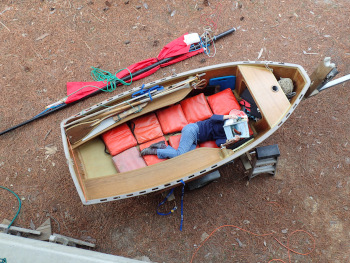 From Cedar Key, lodging is a long day's sail for Clam Girl's ten foot waterline. At our dawdlers' pace, to
make it in one day means perfect timing and conditions, particularly in winter with shorter days
and awkward tides. But, staying out a night or two would ease the distances. Although our coast is lovely
beyond words, as the tide falls accessible camping sites dwindle because of muck, oysters, and marsh.
Mixed semi-diurnal tides further complicate camping. The exquisite answer is anchoring and sleeping
aboard.
From Cedar Key, lodging is a long day's sail for Clam Girl's ten foot waterline. At our dawdlers' pace, to
make it in one day means perfect timing and conditions, particularly in winter with shorter days
and awkward tides. But, staying out a night or two would ease the distances. Although our coast is lovely
beyond words, as the tide falls accessible camping sites dwindle because of muck, oysters, and marsh.
Mixed semi-diurnal tides further complicate camping. The exquisite answer is anchoring and sleeping
aboard.
Anchoring avoids trespassing, too, compared with pitching a tent landward of the beach cusp, which can require early striking and re-stowing. We won't be racing and might need to wait for the tide, anyway, or linger for coffee, or watch clouds or a bird watching us.
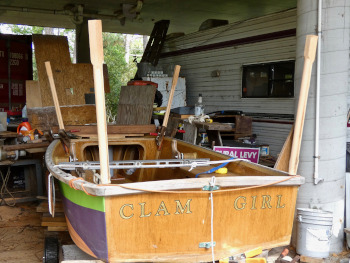 In 1990 I took a week from Cedar Key to Yankeetown and back in Pine Needle, anchoring in the
intertidal zone. She's a sailing canoe for sleeping aboard, 18 and a half feet x 30 inches. Her tent,
netting, and boat cushions made life so delightfully comfortable, I fell asleep to violent splashing as
dolphins herded fish almost ashore onto the oyster shell beach. Another night, I couldn't keep myself
awake listening to a manatee group snoring a hundred feet away on the silent Withlacoochee River.
And, on a windbound day as the tide rose, I watched periwinkles climb marsh grass, while a solid squall
came and went.
In 1990 I took a week from Cedar Key to Yankeetown and back in Pine Needle, anchoring in the
intertidal zone. She's a sailing canoe for sleeping aboard, 18 and a half feet x 30 inches. Her tent,
netting, and boat cushions made life so delightfully comfortable, I fell asleep to violent splashing as
dolphins herded fish almost ashore onto the oyster shell beach. Another night, I couldn't keep myself
awake listening to a manatee group snoring a hundred feet away on the silent Withlacoochee River.
And, on a windbound day as the tide rose, I watched periwinkles climb marsh grass, while a solid squall
came and went.
If Karen and I were caught out - a fair breeze turned foul, say, and failing - could Clam Girl's ten and a third by four and a half feet give us geezers a good night's sleep, under a boom tent?
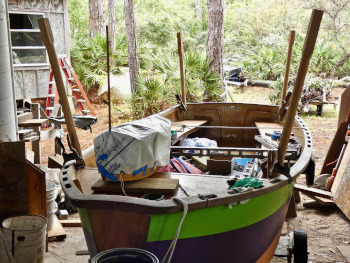 Tent not needed? It's only one night till the next B&B or motel? Should we sleep under a tarp as Webb
Chiles did most of the way around the world in his Drascombe Lugger? No. We're too old and not that
tough, and we like soft pleasures. Why not be comfortable and keep pests out and the inside dry?
While settled onto oysters or mud - with bug netting - waiting for the tide to come can be sublime, even if
those clouds drifting away at sunset return to deluge. On shallow coasts, though, wavelets, meek or not,
can splash past your grounded and anchored boat. A weather eye and understanding of local tides is
crucial.
Tent not needed? It's only one night till the next B&B or motel? Should we sleep under a tarp as Webb
Chiles did most of the way around the world in his Drascombe Lugger? No. We're too old and not that
tough, and we like soft pleasures. Why not be comfortable and keep pests out and the inside dry?
While settled onto oysters or mud - with bug netting - waiting for the tide to come can be sublime, even if
those clouds drifting away at sunset return to deluge. On shallow coasts, though, wavelets, meek or not,
can splash past your grounded and anchored boat. A weather eye and understanding of local tides is
crucial.
Our first trial, under the tall pines in the yard, was to lie on five pairs of boat cushions scrunched onto Clam Girl's open, flat bottom.
"Could you spend a night or two like this?"
Karen thought, 'Is he serious'? But said, "Sure."
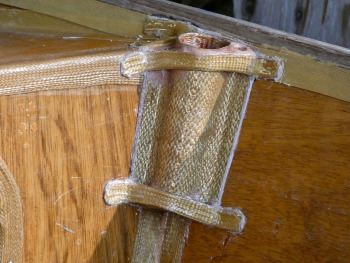 I plied her with tent photos, diagrams, and suggestions from a half dozen dinghy cruising books,
and years of Dinghy Cruising Association bulletins.
I plied her with tent photos, diagrams, and suggestions from a half dozen dinghy cruising books,
and years of Dinghy Cruising Association bulletins.
A.G. Earl's, Dinghy Cruising, 1945, has a still valid summary of six basic tent designs, although it pre- dates tensioned backpacking tents. But, Earl's tents and later ones in the DCA bulletins are for a North Atlantic climate. Here, after a fine sailing day with however enchanting an evening, we'd want netting.
So, a boom tent with the rain fly over the boom and netting under it - the fly down and over the teak with netting led to the rail's slots.
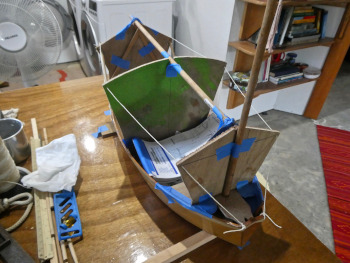 Clam Girl's too small to relinquish sitting headroom out to the sides. Maybe athwartship battens, with the
outboard ends just over head height above the seats, or, modern tent poles bent gun'l to gun'l? Entering
would be over the transom. Smaller access flaps could be abaft her mast. Draw-tight lines, loops and
toggles? Velcro here and there, and a zipper or two?
Clam Girl's too small to relinquish sitting headroom out to the sides. Maybe athwartship battens, with the
outboard ends just over head height above the seats, or, modern tent poles bent gun'l to gun'l? Entering
would be over the transom. Smaller access flaps could be abaft her mast. Draw-tight lines, loops and
toggles? Velcro here and there, and a zipper or two?
As in most too-small boats, gear wants shuffling considerably when changing from sailing mode to sleeping. A backpacking cook kit for coffee and modest meals, and, yes, the Duckworks bucket must fit somewhere.
If I pattern it, Karen says she'll sew it. Ah, ha! A sewing machine could be coming.
~HH